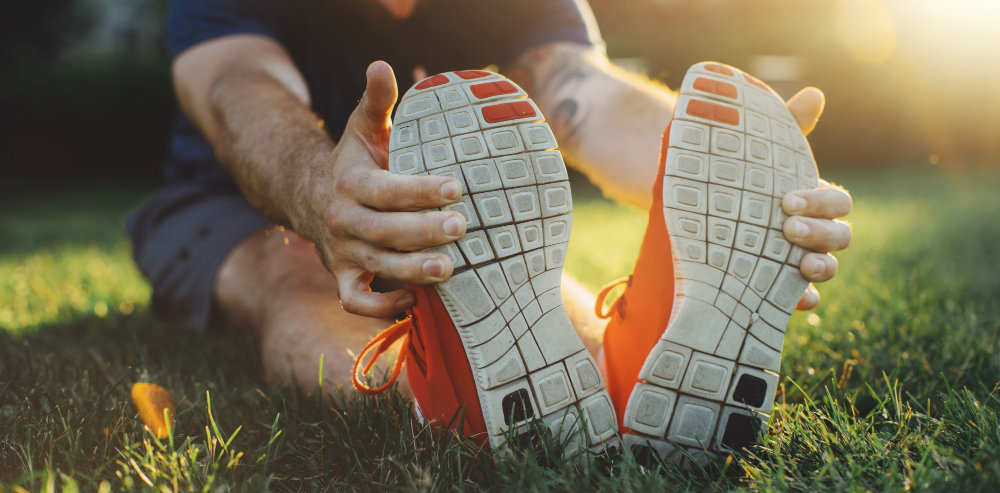Our Top 10 Foot Care Tips
Your feet carry you everywhere you want to go and are intended to last a lifetime. The fact of the matter, though, is that your lower limbs aren’t completely maintenance-free.
Of course, the good news is that most foot care and maintenance is actually pretty easy.
Really, all it takes is a handful of simple measures and you can keep your feet feeling and functioning their very best for a long time. To help with this, we’ve decided to take some time and compile a list of what we consider to be the top 10 foot care tips you should follow:
- Exercise on a regular basis. This is something any doctor should encourage you to do, but might seem odd coming from a podiatrist. The myriad benefits of exercising on a regular basis tend to be fairly well-known – improved cardiovascular performance, weight loss/maintenance, stronger muscles, less fat, etc.
Less well-known (or at least less considered) is how this relates to foot health. A stronger cardiovascular system means the tissues in your feet receive greater amounts of oxygen and nutrients necessary to thrive. Less bodyweight equals less pressure and force placed upon your lower limbs. Stronger muscles and bones are more capable of absorbing the force loads that come from any impactful activity.
The great thing about exercise is that you don’t have to spend massive amounts of time doing it to receive benefits. Elevating your heartrate for just 30 minutes 3-4 times a week is all it takes!
When you begin a new workout program, one of the smartest moves you can make is to check with medical professionals to determine an appropriate level of activity for your current wellness and fitness levels. Our office can identify potential issues in the lower limbs and help you understand how to safely create your exercise routine.
- Eat a well-balanced diet (in moderate portions). As with exercise, it’s easy to think about the overall benefits eating well can bring to your entire body. After all, some of the same benefits—improved blood flow, weight management, strong body tissues, etc.—certainly apply.

There are some additional considerations specific to foot health related to the foods you eat. Sure, proper nutrients are essential for making sure the tissues in your lower limbs are strong and able to keep you moving, but there’s definitely more to the story.
For example, one particular arthritic condition (gout) that can cause tremendous pain at the base of the big toe is caused by certain foods. Knowing which foods (and beverages) to avoid, or at least consume in minimal amounts, can help you prevent a painful gout flare, and even reduce your risk of developing the condition in the first place.
- Wear proper footwear (that fits correctly). It’s easy to look past this when you think of them in the context of style, or don’t give them any thought as you just put them on, but shoes play a big role in foot health. The very reason we wear them is to protect our feet. More than that, footwear provides support and cushioning for our hard-working lower limbs.
The key rules for your shoes is to make sure they are A) activity-appropriate, B) fit well, and C) solidly constructed.
Your shoes need to match whatever activity you are performing (so wear running shoes if you run, basketball shoes if you play basketball, etc.).
For fit, your footwear needs to have roughly a thumb’s width of space between the longest toe and front of the shoe and enough width and height, so toes can wiggle. When laced, the heel should be snuggly cradled and the foot unable to slide back and forth.
When it comes to how footwear is constructed, your shoes need to work with your feet and have ample cushioning and robust arch support. Even better is when they are made out of materials that allow your feet to breathe.
- Trim your nails the right way. Ingrown toenails are a highly common problem, and one that can happen to basically anyone who has toenails. Whereas other conditions might be more prevalent within certain demographics, this simply is not the case for nails that become ingrown. They can happen to men, women, adults, children, Bills fans, etc. without bias.
One possible cause for ingrown toenails is faulty nail trimming practices. The reason for this usually comes down to the simple fact that most people don’t know how to properly clip their toenails, and that’s not their fault. The inherent issue is when the nails are either cut too short or the edges are rounded off.
With regards to the edges being rounded, a likely explanation for this is because it’s how we usually trim our fingernails.
As a general rule, clip your toenails straight across and keep them roughly even with the edge of their respective toes (and not shorter). And for most people, clipping them every 6-8 weeks is usually pretty sufficient.
- Stretch your lower limbs daily. Your feet, ankles, and lower legs contain hundreds of soft tissues (muscles, tendons, and ligaments). Problems arise when these tissues are too tight. In the case of muscles, excessive tightness could lead to a strain.

With regards to the connective tissues, the most common foot issue for adults—heel pain—can be linked to tightness of the plantar fascia and/or Achilles tendon. The former is a cause of plantar fasciitis, and the former Achilles tendinitis.
Fortunately, you don’t have to spend a lot of time stretching the lower limbs every day. Just 5-10 minutes can make a big difference. And you can do this at the same time as you do other activities (like watching your favorite shoes or brushing your teeth).
- Make sure your feet aren’t too wet. Feet are often damp and warm. A major factor in the dampness is the fact feet contain hundreds of thousands of sweat glands. Your body needs these glands to produce sweat so they don’t overheat.
The core issue with this is that microorganisms love damp and warm environments. This increases your risk for conditions like fungal toenails and athlete’s foot – and highlights the importance of keeping your feet reasonably dry (but hold that thought!).
If you are working hard and your feet are sweating a lot—or you have a condition known as hyperhidrosis (excessive sweating)—you need to replace damp socks with dry ones at the earliest opportunity. It also helps to wear moisture-wicking socks and breathable shoes.
- Make sure your feet aren’t too dry. We just noted that “too wet” is a problem, but so is this. When your skin becomes too dry, it can crack and fissure. Sure, this would be an issue anywhere on your body, but it’s especially problematic for your lower limbs.
The reason for this comes down to the fact that deep cracks and fissures in the bottoms of your feet are painful when you stand, walk, or run. More than that, they provide a pathway for microorganisms to enter – and they will because bacteria, fungi, and viruses thrive in warm areas (and your body is a tremendous source of warmth).
To prevent excessive dryness, use a thick moisturizing cream or lotion and especially focus on the heel and forefoot areas. Applying your moisturizer after showering or bathing is best (since it traps in moisture). Use it on the tops, bottoms, and sides, but avoid the spaces between toes – which is ideal breeding grounds for microorganisms.
- Avoid overuse. Yes, exercise is essential for optimal foot health, but too much of virtually anything in life becomes a problem. In this case, the problem often comes down to the tremendous force loads our lower limbs absorb from physical activities. Even walking—which is considered to be low-impact—places up to two times your body’s weight in force on the landing foot with every step. That all adds up over time.
The forces your body needs to endure are even greater for activities deemed to be high-impact, such as those involving running or jumping.
An outstanding option for avoiding overuse is to practice cross-training. You can do this by substituting exercises like cycling, swimming, yoga, or walking a couple of times during the week in place of running or other high-impact activities.
- Practice smart diabetic foot care. If you have diabetes—and almost 1 out of 10 Americans do (along with another 1 out of 3 adults who have prediabetes—you hopefully understand how serious the disease is with regards to risks for serious problems. Diabetes causes systemic damage and increases your odds for heart attacks, strokes, kidney failure, and blindness.
Given the extremely serious nature of those issues, it can be easy to overlook how diabetes affects your feet. That can be a tragic mistake – this disease can potentially result in amputation and even become life-threatening.
We can work with you to develop a diabetic foot care plan based on prevention and early detection to keep your feet as safe and healthy as possible. Following your plan can possibly save your life.
- See your doctor. Perhaps the best tip for foot care is to listen to your body and take the appropriate measures when it’s telling you something is wrong. Pain is a message about an existing problem, not something to be ignored!
If you have foot pain or difficulty, contact us as soon as possible. Why is that so important? Because early medical intervention is always the best. In many cases, treatment will be easier—which means more likely to be treatable without needing surgery—and you don’t have to worry about the problem becoming worse (as problems typically do until they’re addressed).
Our goal at Capital District Podiatry is to make sure your feet are healthy and able to give you the opportunity to do the things in life that you want to do.
If you or any of your family members need professional treatment for foot pain or difficulty, please don’t hesitate to contact us and find out how we can help. For more information or to request an appointment with either our Troy or Clifton Park offices, call (518) 273-0053 or take advantage of our online form.
Troy Office
763 Hoosick Rd.
Troy, NY 12180
Clifton Park Office
855 Route 146 | Suite 150
Clifton Park, NY 12065
© Capital District Podiatry, LLC. All Rights Reserved.
Notice of Nondiscrimination | Privacy Policy | Terms & Conditions
